How to build a house with low environmental impact
Find out how to make your home environmentally friendly, increasing energy efficiency making it class A and reducing pollution and costs.
How to build a low environmental impact house
The residential sector is one of the main sources of pollution; according to The Italian Institute for Environmental Protection and Research (ISPRA), it is responsible for 64% of PM2.5 emissions, 19.5% of the greenhouse gases released into the atmosphere and 13% of nitrogen oxide (NOx) emissions.
There is a clear need to build low environmental impact houses, that minimise energy consumption and predominantly use renewable sources, ensuring a high level of thermal and acoustic insulation, and adequate comfort for residents.
Goals to consider for an eco-sustainable house
Building an eco-sustainable house means creating a living space based on a series of requirements, considering certain characteristics that are fundamental when building a residential property. According to European directives on sustainable construction, it is essential to take into account certain key elements, including:
- Energy efficiency
- Performance of the building materials
- Maintenance of the building
- Active and Passive atmospheric pollution
- Integration with green mobility solutions
- Smart monitoring and control technologies
Findings from EU databases reveal that only 25% of buildings today can be considered as having a low environmental impact, while 75% of houses are not energy efficient. That is why it is necessary to build environmentally friendly houses, so that new buildings have high levels of sustainability, and existing properties are restructured to bring benefits. In particular, it is essential to create houses that are self-sufficient from an energy perspective, meaning that they can produce or reduce the energy they need, using innovative building techniques and focusing on creating energy efficiency inside the house. It is also important to plan so that the house only needs basic maintenance, equipping it with suitably advanced technology. A low environmental impact house should also have integrated green mobility solutions, for example charging points for zero-emission electric vehicles. It is also important to use certified eco-friendly materials, to protect the marine and terrestrial ecosystem, and to ensure the quality of the air indoors, using modern technology to control the systems and optimise consumption.
Aspects to evaluate when choosing building materials
One of the main aspects when building an eco-sustainable house is choosing natural materials, that are sourced without damaging the environment and are safe for the residents of the property. For example, certified wood from controlled production lines, eco-friendly insulating materials used in sustainable architecture and bioarchitecture such as hemp, coconut or cork fibres, or composite materials like recycled concrete and eco-friendly cement, glass and natural clay. The materials used should provide the appropriate heat performance for the type of building and the climate in that geographic location, to minimise the energy consumption required for both heating and cooling. For health and safety, it is also fundamental to use non-toxic coatings and substances, decorating the house in an environmentally friendly way but also in a safe way in terms of health, reducing the use of chemical products and favouring the simple, natural cleaning of indoor spaces.
Energy production in an eco-sustainable house
Making a house sustainable means equipping the building with efficient solutions for the self-production of electricity, for example by installing a photovoltaic system on the roof to obtain clean energy, a solar thermal system to supply domestic hot water with zero emissions, or a heat pump for domestic heating. It is essential to use renewable sources to reduce atmospheric pollution, with the possibility of consuming the energy produced and giving any excess to the public network or neighbours.
Obviously, it is crucial to have storage systems, installing high-capacity batteries that can store excess energy. That way, you can reduce energy waste, storing any surplus for use at another time (at night or on days where radiation from the sun is low). It is also necessary to take into account the options available. For example, you can diversify energy sources, integrating photovoltaic system with mini wind turbines.
Energy-efficient solutions for a low environmental impact house
As well as generating the heat required on site, a low environmental impact house must provide maximum energy efficiency. This objective requires a 360-degree approach, designing every aspect of the house carefully. Above all, the property must have a good level of thermal insulation, to reduce the energy required for cooling in summer and heating in winter, carrying out insulation work and adopting solutions like an exterior insulation finishing system. At the same time, it is possible to add solar screens to glass surfaces to keep energy costs down, increase home comfort and enjoy more light. Acoustic insulation should not be underestimated either, as it protects the house from external noises using soundproof and sound-absorbing materials. Energy efficiency also requires a considerable amount of natural light, which can be completed with environmentally friendly options like LED lighting systems and outdoor solar lights.
Eco-sustainable houses: the importance of home automation
New technologies allow you to control energy consumption in the home in an optimal way, preventing a house that has been built in an eco-friendly way from losing its ability to operate with minimal environmental impact. Domotics, or home automation, allows you to improve the wellbeing of residents and the natural ecosystem, making electronic appliances and devices smart so that they can work efficiently based on the needs at the time. A smart home does not necessarily require a high level of automation, in fact, simple energy control systems are enough to achieve notable benefits. For example, with modern temperature control technology, it is possible to reduce energy consumption in the home, optimising the operation of the heating and air conditioning with modulating thermostats or by connecting external temperature probes to minimise the system’s operation. The same applies to smart power sockets, connected household appliances and smart meters to monitor continuous cycle consumption remotely.





